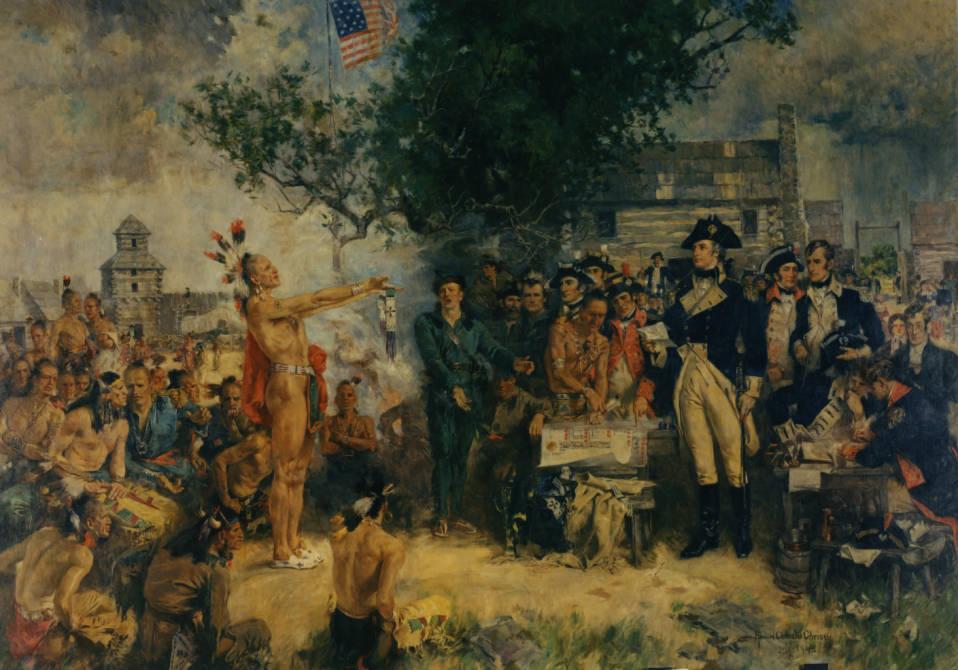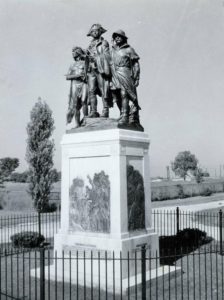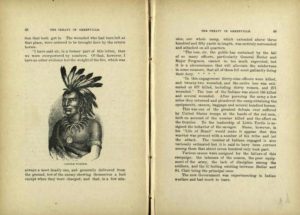Painting a Picture: Battle of Fallen Timbers

Those of us who bring you Ohio Memory are, as you might imagine, enthusiastic about Ohio’s history. We love to share materials from our collections and tell you about events that may have escaped your notice or not been on your radar since your school days. There are times, however, when we want to share a topic with you but are unfamiliar with the facts surrounding it. What do we do when that happens? We turn to our own collections!

Saturday, August 20, marks the anniversary of the Battle of Fallen Timbers. Fought in 1794, Fallen Timbers was the last major conflict in the Northwest Territory Indian War and resulted in the Treaty of Greenville in 1795. Engaged in the conflict were U.S. troops, led by General Anthony “Mad Anthony” Wayne, and a confederation of American Indian tribes, including the Miami, Shawnee, and Lenape. The battle was fought near present-day Toledo on the Maumee River.
These are the facts as we know them and as can easily be found via a variety of sources. However, Ohio Memory seeks to bring a more well-rounded view of topics but, because some topics are outside our expertise, this can be challenging. Because the Battle of Fallen Timbers is one of those topics, it was necessary to delve into the materials in our collection to progress past a “just the facts” point of view.
Portraits and other images illustrate stories, adding depth and providing a new way to understand the events of our past. In the case of Fallen Timbers, Ohio Memory features portraits of such major players as General Wayne and Tarhe, the Chief of the Wyandot tribe and one of several signers of the Treaty of Greenville. Artistic depictions of major events can add vibrancy and personal interest, as is the case with the paintings “Charge of the Dragoons at Fallen Timbers” and “Signing of the Treaty of Green Ville.”

We look to accounts from all sides in an effort to represent events as accurately as possible but this can be complicated. As we have heard many times, the victors write the history books. Add to this the fact that American Indian groups have historically tended toward an oral, rather than written, tradition, and we face the very real concern that our histories are, for lack of a better word, lopsided. Fallen Timbers is a case-in-point. All of the historic written materials on Ohio Memory regarding the Fallen Timbers battle were authored by men of European descent, one of whom wrote about the Treaty of Greenville after the fact, and one whose daily journal of his time with General Wayne was published for distribution. A third document, published by the Ohio State Auditor in 2007 and targeted towards school children, discusses the events that led to the battle as well as the battle itself, all from the perspective of European settlers (to read the piece regarding Fallen Timbers, please scroll to page 58 of the linked document). It is important to note that Ohio Memory does hold two documents relating to the Shawnee and the effects that the Treaty of Greenville had on the tribe, but neither is written by tribal members.
Organizations that share their digital materials through Ohio Memory are proud of our collections. We recognize, however, that no single collection is complete. No single institution holds every last piece of information regarding any topic. Collectively, though, we are able to paint a picture that includes significantly more details than if we attempted to paint that picture without the help of our many contributors. The materials used for this piece, and the accompanying images, came from four different collections in Ohio Memory. Each complements the others and makes the painting more complete.
Now that school has begun again throughout most of Ohio, you or your kids may need to do a bit of research of your own. Don’t forget about Ohio Memory, where you can find many wonderful materials for you to use to complete your own painting of the past.
Thank you to Shannon Kupfer, Digital Initiatives Librarian at theState Library of Ohio, for this week’s post!



Leave a Reply
You must be logged in to post a comment.